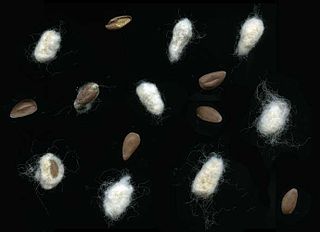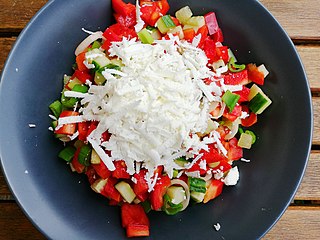 Raheb salad | |
| Type | Salad |
|---|---|
| Main ingredients | Eggplants, tomatoes |
Raheb is a Lebanese salad with aubergines, eggplant, and tomatoes, often served as part of a selection of mezze. [1] [2] Raheb is Arabic for "monk." [3] [4]
 Raheb salad | |
| Type | Salad |
|---|---|
| Main ingredients | Eggplants, tomatoes |
Raheb is a Lebanese salad with aubergines, eggplant, and tomatoes, often served as part of a selection of mezze. [1] [2] Raheb is Arabic for "monk." [3] [4]
A typical recipe of raheb has the following nutritional values per serving: [5]

Eggplant, aubergine, brinjal, or baigan is a plant species in the nightshade family Solanaceae. Solanum melongena is grown worldwide for its edible fruit.

Vegetable oils, or vegetable fats, are oils extracted from seeds or from other parts of fruits. Like animal fats, vegetable fats are mixtures of triglycerides. Soybean oil, grape seed oil, and cocoa butter are examples of seed oils, or fats from seeds. Olive oil, palm oil, and rice bran oil are examples of fats from other parts of fruits. In common usage, vegetable oil may refer exclusively to vegetable fats which are liquid at room temperature. Vegetable oils are usually edible.

Shawarma is a Middle Eastern dish that originated in the Levant region of the Arab world during the Ottoman Empire, consisting of meat that is cut into thin slices, stacked in an inverted cone, and roasted on a slow-turning vertical spit. Traditionally made with lamb or mutton, it may also be made with chicken, turkey, beef, or veal. The surface of the rotisserie meat is routinely shaved off once it cooks and is ready to be served. Shawarma is a popular street food throughout the Arab world and the Greater Middle East.

Cottonseed oil is cooking oil from the seeds of cotton plants of various species, mainly Gossypium hirsutum and Gossypium herbaceum, that are grown for cotton fiber, animal feed, and oil.

Baba ghanoush, also spelled baba ganoush or baba ghanouj, is a Levantine appetizer consisting of finely chopped roasted eggplant, olive oil, lemon juice, various seasonings, and tahini. The aubergine is traditionally baked or broiled over an open flame before peeling, so that the pulp is soft and has a smoky taste. It is a typical meze ('starter') of the regional cuisine, often served as a side to a main meal and as a dip for pita bread.

Iraqi cuisine is a Middle Eastern cuisine that has its origins in the ancient Near East culture of the fertile crescent. Tablets found in ancient ruins in Iraq show recipes prepared in the temples during religious festivals—the first cookbooks in the world. Ancient Mesopotamia was home to a sophisticated and highly advanced civilization, in all fields of knowledge, including the culinary arts.

Parmigiana, also called parmigiana di melanzane, melanzane alla parmigiana or, in the United States, eggplant parmesan, is an Italian dish made with fried, sliced eggplant layered with cheese and tomato sauce, then baked. The origin of the dish is claimed by the Southern regions of Calabria, Campania, Apulia and Sicily. Other variations found outside Italy may include chicken, veal, or another type of meat cutlet or vegetable filling.

Sunflower oil is the non-volatile oil pressed from the seeds of the sunflower. Sunflower oil is commonly used in food as a frying oil, and in cosmetic formulations as an emollient.

Maqluba is a traditional Levantine dish that is popular across the Levant including in Palestine, Jordan, Syria, Lebanon, and Iraq.

Caponata is a Sicilian dish consisting of chopped fried eggplant/aubergine and other vegetables, seasoned with olive oil, tomato sauce, celery, olives, and capers, in an agrodolce sauce.

Afghan cuisine is influenced to a certain extent by Persian, Central Asian and Indian cuisines due to Afghanistan's close proximity and cultural ties. The cuisine is halal and mainly based on mutton, beef, poultry and fish with rice and Afghan bread. Accompanying these are common vegetables and dairy products, such as milk, yogurt, and whey, and fresh and dried fruits such as apples, apricots, grapes, bananas, oranges, plums, pomegranates, sweet melons, and raisins. The diet of most Afghans revolves around rice-based dishes, while various forms of naan are consumed with most meals. Tea is generally consumed daily in large quantities, and is a major part of hospitality. The culinary specialties reflect the nation's ethnic and geographic diversity. The national dish of Afghanistan is Kabuli palaw, a rice dish cooked with raisins, carrots, nuts, and lamb or beef.

Emeril John Lagasse III is an American celebrity chef, restaurateur, television personality, cookbook author, and National Best Recipe award winner for his "Turkey and Hot Sausage Chili" recipe in 2003. He is a regional James Beard Award winner, known for his mastery of Creole and Cajun cuisine and his self-developed "New New Orleans" style. He is of Portuguese descent on his mother's side, while being of French heritage through his father.

Many cuisines feature eggplant salads and appetizers.

Harissa is a hot chili pepper paste, native to the Maghreb. The main ingredients are roasted red peppers, Baklouti peppers (بقلوطي), spices and herbs such as garlic paste, caraway seeds, coriander seeds, cumin and olive oil to carry the oil-soluble flavors.

Shopska salad is a cold salad popular throughout Southeastern Europe. It is Bulgaria's most famous salad and national dish.

Middle Eastern cuisine or West Asian cuisine includes a number of cuisines from the Middle East. Common ingredients include olives and olive oil, pitas, honey, sesame seeds, dates, sumac, chickpeas, mint, rice and parsley, and popular dishes include kebabs, dolmas, falafel, baklava, yogurt, doner kebab, shawarma and mulukhiyah.

Bulgur, or burghul, is a cracked wheat foodstuff found in West Asian cuisine.

Mechouia salad is a Tunisian salad. A very popular first course dish from Tunisia, a country in North Africa that appreciates spiciness, it is especially consumed in the summer, and is a grilled vegetable, tomatoes, peppers, onions and garlic salad, that may also contain eggplant. They are grilled in the oven or on the stove and then ground together, spiced, and then tuna and olive oil are added, and sometimes boiled eggs are placed for decoration.